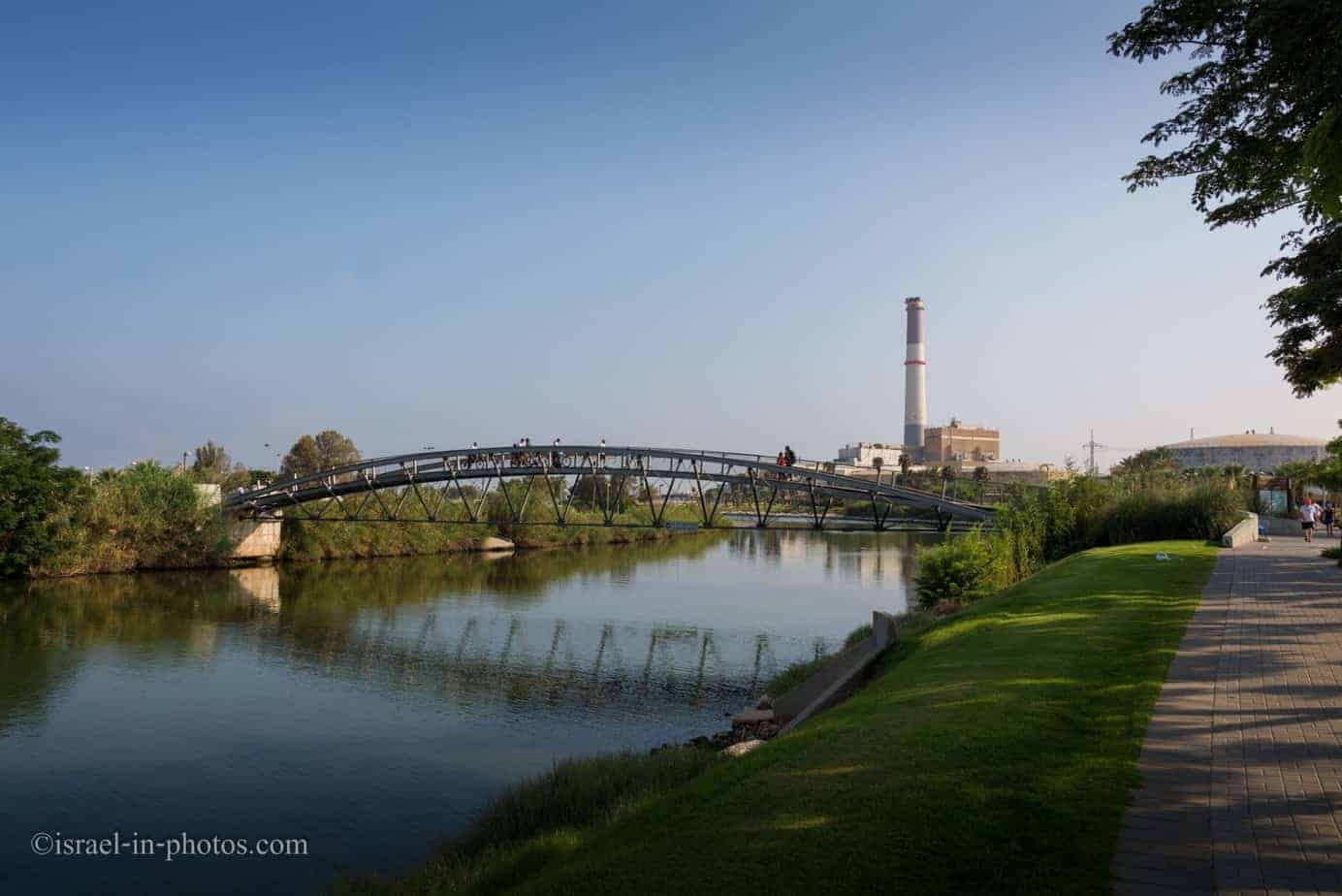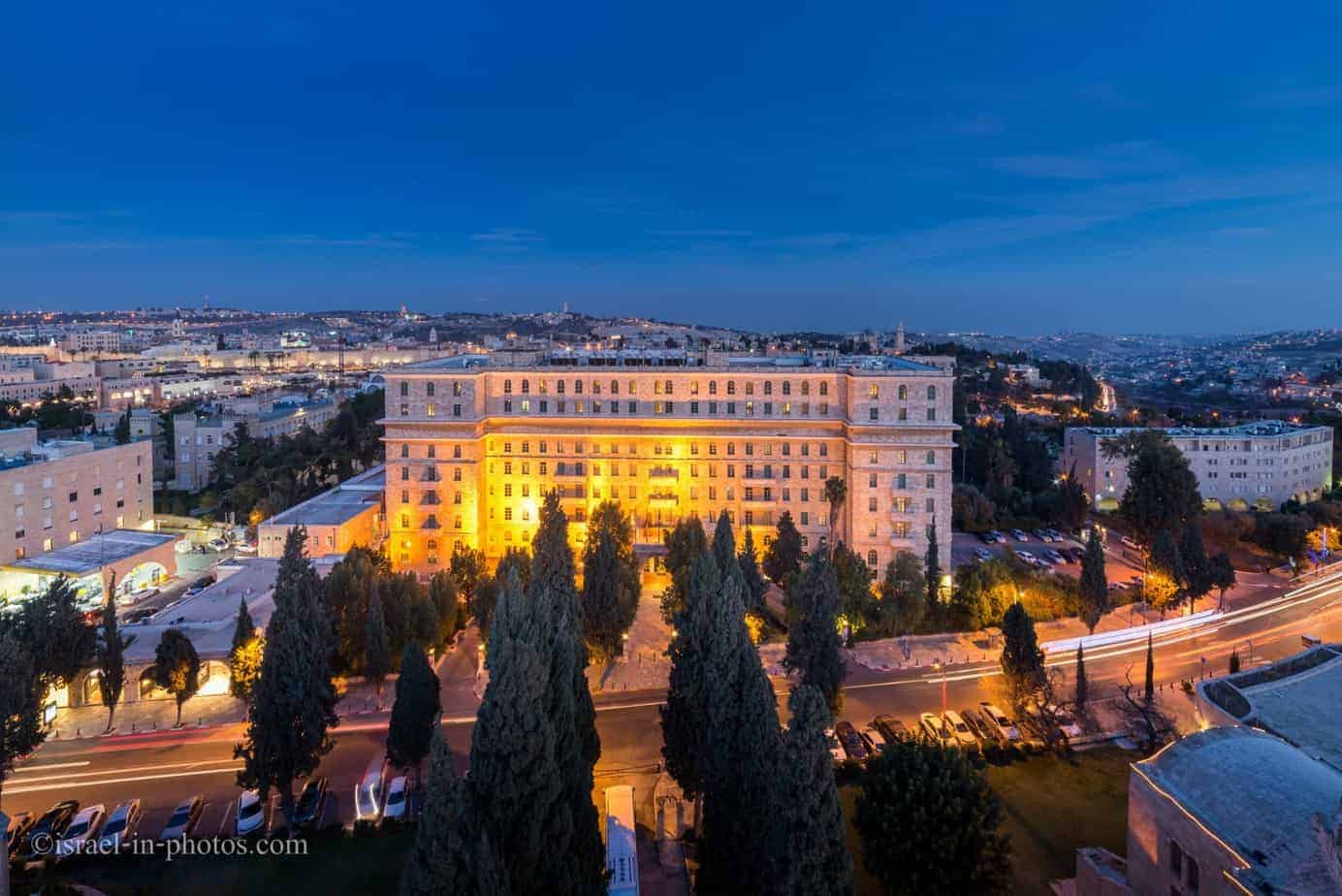Nahum Gutman Museum of Art, Tel Aviv, Visitors Guide
The Nahum Gutman Museum of Art in Tel Aviv has a permanent exhibition dedicated to the artist and several temporary exhibitions.
Table of Contents
Map
Nahum Gutman Museum of Art is located at Shimon Rokach Street 21, Tel-Aviv. You can use the light rail and get off at the Elifelet station. Or you can park at the HaTachana Compound and walk from there.
Directions for drivers: Link to Waze and Link to Google Maps
Directions for public transport: Link to Moovit
Interactive map of the area:
Opening Hours
Sunday: Closed
Monday – Thursday: 10:00 – 16:00
Friday: 10:00 – 14:00
Saturday: 10:00 – 15:00
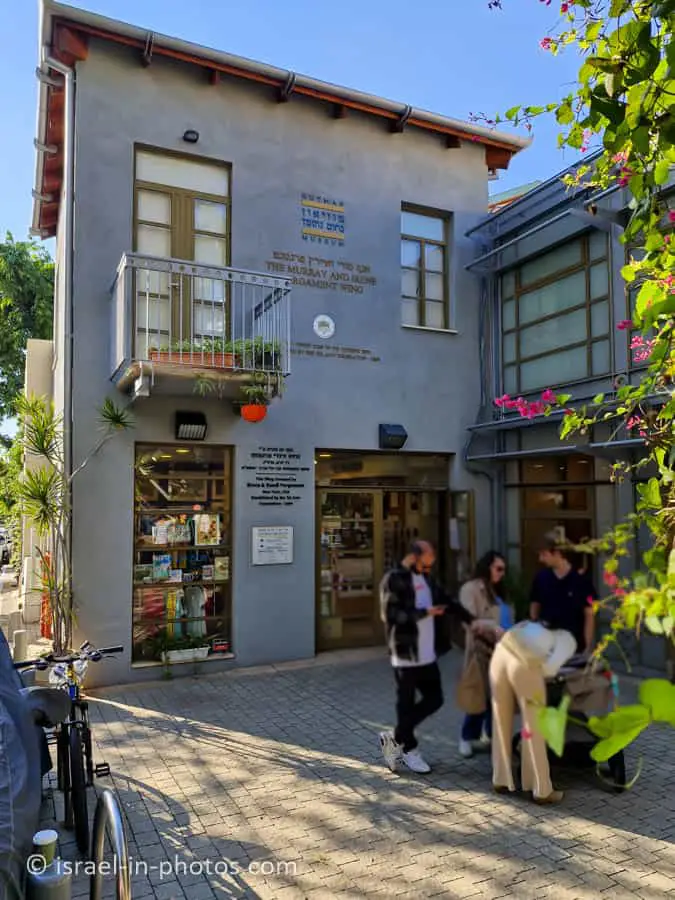

Entrance Fee
Regular entrance fee: 35 NIS
Children (0 – 18): free
Pensioner – 18 NIS
Student – 20 NIS
Tel Aviv – Jaffa resident: 20 NIS
Notes:
- Besides regular visits, there are tours and workshops for kids and adults.
- You can purchase tickets at the official website or the souvenir shop in the museum.
- Opening hours and ticket prices were updated in December 2024. In any case, recheck the official website before visiting.
About the Museum
The museum has a permanent collection of Nahum Gutman’s work (ground floor) and several temporary exhibitions (first floor).
The museum is accessible to people with disabilities.
The Nahum Gutman Museum of Art was opened on May 3rd, 1988, by the Nahum Gutman Society and the Tel Aviv Foundation in the presence of Israeli President Ezer Weizman. The entire museum collection was donated by the artist’s family, who wished to emphasize Nahum Gutman’s multi-dimensional character and portray him as a painter, illustrator, sculptor, and children’s author, thus allowing the public to become acquainted with his oeuvre.
The museum’s first director and founder was the late writer and curator Yoav Dagon. The museum was established in a historic house built by the Schulman family in 1887, one of the first 48 houses forming the nucleus of Neve-Zedek. Information about the Schulman House and its many residents can be found in the book: “Tel Aviv, Exposed”, by Goldberg, Widrich and Amit-Cohen, pp.43-46.
Between the years 1907 and 1914, the building that now houses the Gutman Museum was used as the office of the periodical “Hapoel Hazair” and as a residence for its editor, Joseph Aharonovitch, and the writers Joseph Chaim Brenner and Dvora Baron. In 1912, Dvora Baron, the periodical’s literary editor, married Joseph Aharonovitch. The house became the literary center and meeting place for the group of Hebrew writers who marked the beginning of the new Hebrew culture, and became known as “The Writers’ House”.
Through the years, the house was badly damaged, and in the 60s, it was finally abandoned and condemned by the Tel Aviv/Jaffa Municipality.
After a lengthy public debate involving members of the Knesset (The Israeli Parliament) and the Israeli Preservationist Society, the house was declared a landmark and subsequently purchased by the Jewish National Fund. Reconstruction began in 1992, with the initiative of the Doron Foundation, the Tel Aviv Foundation, and a special contribution from Irene and Murray Pergament (U.S.A.) in memory of their daughter, Sherri P. Koeppel.The northern wing was historically reconstructed, while the architect Ronny Zeibert modernly renovated the southern wing.
On the initiative of the Gutman Family and the Gutman Society, the Tel Aviv/Jaffa Municipality decided to devote “The Writers’ House” to Gutman’s work.
On the 9th of September 2009, the museum’s new, adjacent wing was officially opened, just where the “Nukata,” the Turkish Guard, had once stood during the founding of Neve-Zedek.The museum exhibitions create a meeting space between Gutman and young Israeli contemporary artists, creating a cultural dialogue between old and new works of art. Visiting the museum exposes visitors to a wide range of Israeli artistic endeavors, including an inner cultural dialogue between the different eras and perspectives. The fact that Gutman drew both Tel Aviv and Jaffa, portraying Jews and Arabs with the same amount of love and interest, provides us with a wonderful tool for the teaching of tolerance as well as a cross-cultural meeting place.
The Nahum Gutman Museum of Art is funded by the Tel Aviv/Jaffa Municipality, the Ministry of Education’s Cultural Affairs Bureau, and private donors.
Source: official website



Nahum Gutman – Permanent Exhibition
We started on the ground floor with the permanent exhibition.
The Nahum Gutman Museum collection, a part of which is on view here, was donated by the artist’s family to shed light on Gutman’s diversity and to acquaint the public with his work. Gutman was a founder of Hebrew art in Israel, a painter, illustrator, sculptor, and writer for children.
Gutman was born in 1898 in Telenesti, Bessarabia (now Moldova). He immigrated to Israel with his parents and siblings at the age of 7, and they were among the 66 founding families of Tel Aviv. As a child, Gutman followed the city’s establishment, documenting his memories from its early days in works of art. Concurrently, he depicted Arab Jaffa, its inhabitants, and surrounding orchards. His works provide a glimpse into the lives of these two populations on either side of the Jaffa-Tel Aviv road.
Source: official website
Here are several photos from the exhibition:
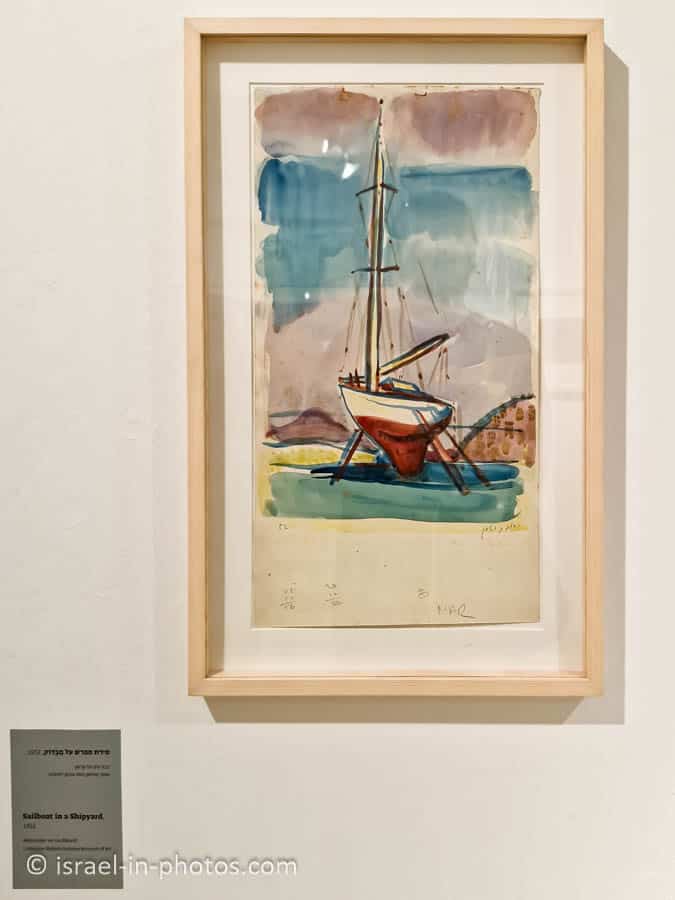










Also, on the ground floor, a small exhibition shows Nahum Gutman’s illustrations of children’s poems. The display is called “Run My Little Horse!”.

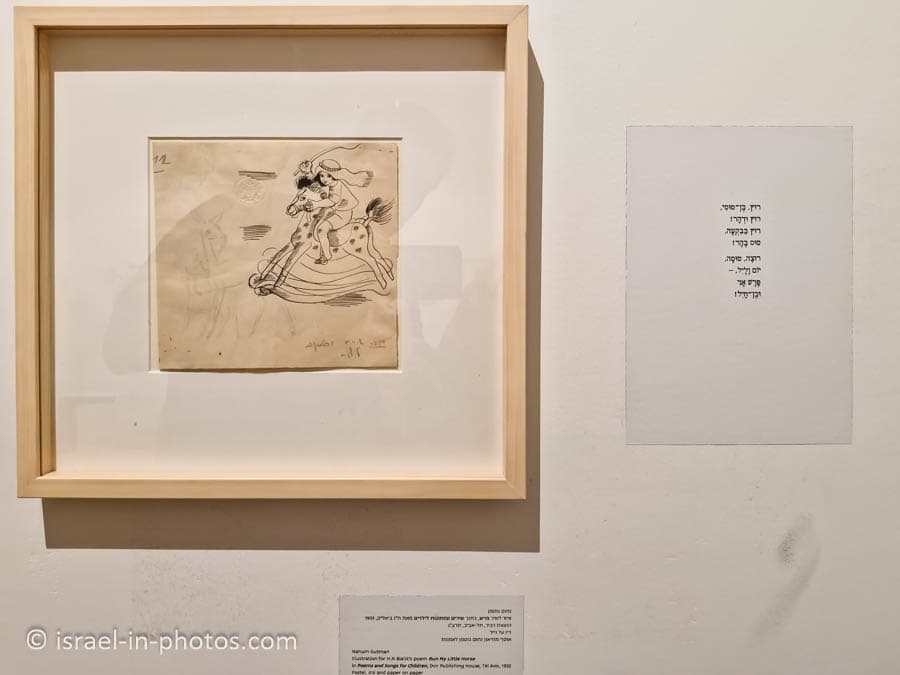
Disaster and Dream – Temporary Exhibition
On the first floor, we saw a temporary exhibition called: “Disaster and Dream” – Yearnings for Redemption in Nahum Gutman’s drawings.





Mt. Krazy
The last exhibition we saw (also on the first floor) was called “Mt. Krazy.”
A chance encounter in Switzerland between two Israeli hikers — Oree Holban (artist) and Ido Rosenthal (combat soldier and mountain climber) formed a connection between two seemingly different people. They connected momentarily in the way that two strangers may meet and become friendly, open, and close in a foreign country. Neither one could see into the future: no one could have known that Ido, a fighter from the elite Shaldag unit, praised for his bravery, nicknamed “Krido” (the contraction of “Crazy Ido”) by all who knew him would be killed while defending Kibbutz Alumim against Hamas terrorists on October 7, 2023.
Holban saw him as a sensitive, open person with a love of humanity and a thirst for life. They met when Oree was at a personal crossroads in his life and was searching for a spiritual path. The ease with which Holban saw him climb, without fear of losing his hold on the ground, inspired him on his journey.
Equipped with tools of meditation and mindfulness, which Holban acquired since the encounter in Switzerland, the exhibition became a place beckoning to process the experience of crisis and destruction, but also as finding peacefulness within the eye of the storm. It is a kind of secret hideaway with an almost impossible combination of the pastoral Alpine hike, Indian meditation caves, and the landscapes of the Gaza Envelope.
Holban wrapped the exhibition space with carpets and vibrant felt fabrics to create an environment comprising colorful cutouts, neon lights, toys, music, climbing walls, meditation caves, a bridge, a river, a cable car, and a small mountain. This sensory-rich environment brings to mind a Snoezelen room – a controlled multisensory environment designed to treat anxieties and physical and emotional pain. In our current reality, all of us are seeking shelter to observe the threatened places in the mind and find powers of compassion, selfless giving, and healing.
Holban’s hybridization of autobiographical materials and public traumatic events has been translated into a carnivalesque exhibition bursting with overflowing images and happenings. “Mt. Krazy” invites visitors to recognize the fragility of life while acknowledging the suffering, the truth, and the beauty comprised within.
Source: sign







Summary
Nahum Gutman Museum of Art is a small museum. And on our latest visit, we spent an hour there (we visited with kids). If you love art, I would suggest visiting this museum as a part of a tour of the nearby neighborhoods: Neve Tzedek Neighborhood or Graffiti in Florentin.
Have you been to this museum? If so, please share your experience in the comments below.
That’s all for today, and I’ll see you in future travels!
Stay Tuned!
Additional Resources
Here are several resources that I created to help travelers:- Trip Planner with Attractions and Itineraries is the page that will help you create your perfect travel route.
- What is the Best Time to visit Israel? To answer this question, we will consider the weather, prices, holidays, festivals, and more.
- Information and Tips for Tourists to Israel will answer the most common questions tourists have about Israel (including safety, passports, weather, currency, tipping, electricity, and much more).
- Israel National Parks and Nature Reserves include a complete list, top ten, map, tickets (Israel Pass, Matmon, combo), and campsites.
- If you are looking for things to do, here are the pages for Jerusalem, Tel Aviv, Haifa, Sea Of Galilee, Akko (Acre), Eilat, Nazareth, Safed (Tzfat), and Makhtesh Ramon.


